
via @sortingtrolley, sponsored by Borders
Summary
This past week, 44 social media performers (including yours truly) across three continents and a half dozen countries carried out @Platea Project II: Co-Modify. The idea was simple. First, choose a megacorporation to be “sponsored by” for the week. Then, act it out, in whatever way you imagine the sponsorship is defined by your company. Like Project I: The Great Yawn, it was slightly self-referential, in that it looked at social media and was designed as a commentary on the commodification of social media, and, by extension, our social lives in general.
The performance was free-form and social, with only basic guidelines. Unlike The Great Yawn, which lasted some 10-15 minutes, Co-Modify played out over an entire week. It seemed important to me, when thinking about sponsorship, that the performances have enough "breathing room" to develop and set hold. I suspected, firstly, that the novelty of performing a sponsorship would capture the performers' imagination for the first few days. This definitely proved true, especially on Sunday morning, when Twitter was abuzz with brand endorsements and strategic product placement. I also suspected that much of the backlash and hesitation about the project would occur in the first few days.
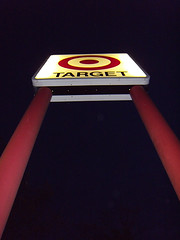

Target and Twinings, by @joanie_s_c and @runefox
I also took Co-Modify closer to the Web 2.0, social media ethos that's developed over the past few years. Call it Art 2.0--art that's crowdsourced but also collective. The problem with The Great Yawn is that performers hadn't added each other beforehand, so they couldn't see each others' creative interpretations of the prompt. It seemed important to me when constructing the concept that the performance take a collective scale. It had to present a micro-vision of a world in which marketing and product placement have leapt from the billboards and televisions and entered our daily lives and social interactions. At the same time, it had to look at how we, as performers and social media users, participate implicitly or explicitly in this ad-driven social world.
Together, these two elements (time and scale) led to something interesting. By Wednesday, during a massive group hug fest that spontaneously erupted amongst the performers, it seemed like we had reached a crescendo. By Thursday, the ads continued, but the rhythm entered something that I've witnessed when, for instance, Facebook has changed its feed structure: with a few exceptions, it normalized. It became habitual. By Saturday, many performers said they'd miss performing, and a number of them ended it with their own grand finale.

@remaerdyaD's live Lego rendition of Amazon products as @runefox and @clockity look on
Ars Ad Absurdum and the Social Media Carnival
I must say that the performance went far beyond what I ever imagined and took a life of its own. From Target dolls to Aussie hairspray fire to the most subtle of product placement to philosophical discussions on the nature of a commodified world, the @Platea performers stunned me with their brilliance and creativity. Product placement has never been so thought-provoking... and downright hilarious at times. If what you see here seems silly, it probably is. But just as play serves a function in childhood, so can "serious play" and comedic commentary serve a function for grown-up performers.
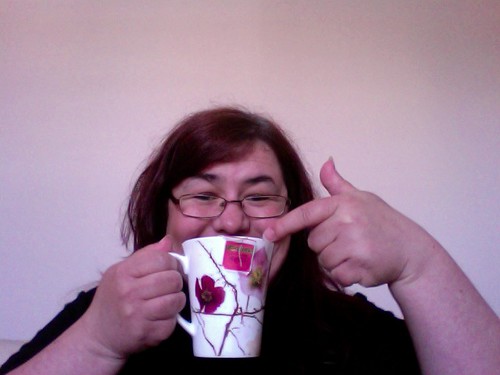
@runefox shares a cuppa
Performer Joelle Held blogged, tongue-ever-implanted-in-cheek, "I look forward to the other 40-some participant posts, and the confusion that it brings to my Facebook friends. In the mean time, I must retire to my Microsoft pillow and sleep." Jennifer Ng compared the performance to the carnival: "The carnival is a feast, where people can reverse roles, be lifted from dominant, mainstream constraints and legitimately subvert authority. With the intense clashes, one form of discourse is pushed to communicate with another. In the case of Co-Modify, the popular against the corporate."
Jonny Gray (who we'll be hearing from later this week) waxed poetic: "And whatever may have been said about the conundrums of art in a consumerist society or the efficacy of artist activism, I feel so much more alive this week as I do this work, this serious play." During the performances, a phrase popped into my mind, borrowed from the philosophical technique of reductio ad absurdum. In reductio ad absurdum, philosophers trying to prove a point take an idea to its logical ends, to the point of absurdity.
Latin nerd that I am (ask me why I choose the name "@Platea"), I thought to myself, "This is ars ad absurdum." Art taken to the point of absurdity. I'm thinking about other Net art projects, like Rachel Perry Welty's "Rachel is" and 0100101110101101.org's Life Sharing, that rely on basic Internet practices taken to the a logical end. In the former, Rachel Perry Welty shares the entirety of her day on Facebook, minute by minute. In the latter, 0100101110101101.org share the entire contents of their computer.
For this performance, we looked at the monetization of social media and the trending of contextual ads deeper and deeper into our social lives, and what do you get? Advertising embedded in the daily lives of individuals, as individual citizens become sponsored by corporations.

@GinaS263 pitches Samsung on Ravelry
The Performers, or, We're All Bilingual Now
What happens when you organize the creative energies of artists from California to Michigan to Switzerland to Australia? "Confusion." "Carnival." "Serious play." "Ars ad absurdum." Performance art that is both fun and engaging but that also asks some basic, thought-provoking questions about the direction of social media and the 21st century, as marketing and our social lives see more and more frequent intersections. Not everyone agreed with this assessment of course, and I personally know I lost a few followers as a result. We'll be hearing more from Ingrid on this, but let's focus on the positive for now.
The collective performance took four broad categories: Storytellers, Subversive, Overt, Embedded. The lines between these categories, of course, are blurry, especially between overt and embedded performers, but I'm going to try to impose this artificial category anyway. Let's take a look:
Storytellers
In an epic grand finale, @whore_hay tells a story of a human Q-Tip. See the entire performance here.
The storyteller performers told a fictional story about their brand. At first glance, it could have been taken seriously, but over time, the story just a little too far-fetched to be real. @alijgordon told a lovely tale about a day spent with Tampax in her nose. @christinielsen constructed an entire product trial of C-Urchin, a facial cream of dubious origin equally-dubious effectiveness. And @yberryfurrealz shared quips and facts about Pfizer products with unusual uses.
Subversives
@_randomthoughts takes a second look at Tweety bird..
Subversives actively deconstructed their brand. Rather than true endorsement, they didn't shy from looking at the downside of their product, or the connotations of their product, or something entirely other than their product. @_randomthoughts tweeted about Twitter, with lyrical imagery drawing from bird- and spring-like connotations of the word "twitter." @bungy32 at once promoted Adobe products and at once questioned their usefulness, all the while asking why he participated in the project at all. Husband and wife duo @cmonstah and @elcelso both openly parodied their brands, with the former interrupting her tweets to remind us about Microsoft Vista's famous uselessness, and the latter shouting out messages from "əl facəbook®". @joelleheld, on the other hand, made up uses from Microsoft products that simply don't exist (as of yet!), and @remaerdyaD, well.. you'll just have to follow his feed to see the fun things he did with Amazon products (including live streaming as he clicked through).
Overt Sponsorship
@rubaiyat's actual search results on Google, along with suggested related searches
@raggedj peddling Aussie hair products... despite having no hair.
Those with overt sponsorships took on the classic salesman role, overtly promoting and pushing their product onto others. @cerob, for instance, asked if @plotbunnytiff used Wonderbread for her sandwich. @hragv reminded us that his tweets are brought to us by Marshmallow Fluff. @G_Greenhouse and @alisonaurelia (whom we'll be hearing from later this week), reminded us that "Organic Miracle Gro is now the same price as regular Miracle Grow.....for a limited time only!!! Hurry this won't last!!!" @printgirl08 recommended Burt's Bees when I was feeling stressed out, and @sw00p, well, his products lent themselves to multiple innuendos when "tied into" other products.
Embedded Sponsorship
@printgirl08 kept Burt's Bees on her desktop while she worked and tweeted.
And the majority, including me, embedded their sponsorships within their daily lives. This doesn't surprise me, as the trend as of late of Internet advertising is that ads are now embedded with the social media we utilize. From contextual ads in Gmail to Facebook ads that advertise to your interests, location and even sexuality, to the physical world, where almost all of us inevitably become walking advertisements for the products we use and prefer, from beverages to clothing to cell phones.
From @micrathene rewarding herself for a long week with some Ben and Jerry's, to @prologi relaxing with a cup of Lipton, to @sheepwithblogs sipping Diet Coke to stay awake, to @tainab enjoying a McDonald's sundae on May Day, these @Platea performers enacted a world that's probably not all that far from reality. I could easily see @cobwebsstir downing Diet Coke Plus, and @happeningfish slipping on Nikes for her run, and @jjcasey mowing the lawn in his New Balance shoes and @laurel43 taking an In-N-Out burger break. Embedded sponsorship is the natural language of advertising, a language we speak each day simply by engaging in the contemporary world.
Collaborative Sponsorship
From @sortingtrolley's "Together At Last" co-branding series. See more here.
So I lied. There's a fifth group that emerged, I think around Tuesday or Wednesday, and it's a perfect example of the social aspects of Web 2.0. These were the collaborative sponsorships, i.e., sponsorships that took on more than one brand. As all our performers were following each other, we could see the promos being done and the marketing slogans used. Pretty soon, spontaneous cross-promotions emerged, from Q-Tips and KFC to Borders and Papaw. Other trends, like subliminal advertising and hashtags, spread virally amongst the performers.
An Advertised Tension
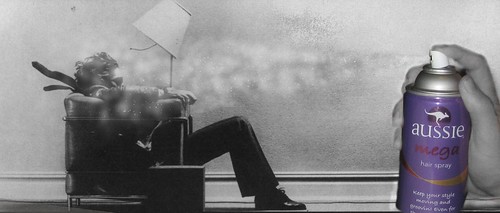
@raggedj sprays away
Despite the variety of these amazing performances, and the broad range in which individual performers interpreted and carried out the basic concept and structure, I could sense a tension throughout. On the one hand, it seemed like most of the performers had used their products and felt in some way connected to them. Even the most mocking subversives demonstrated a familiarity with the brand that suggests it's had some function in their lives. On the other hand, I also picked up a profound discomfort with the march of advertising into our very basic social lives and private correspondence, and it felt as if (and maybe I'm projecting here) the hyper-exaggerated product placements and brand endorsements served to assuage this discomfort through comic relief.
Through it all was a fluency with the language and customs of advertising. Language that we don't use in day to day life but that is nonetheless thrown at us everyday. Was it mindless parody? Thoughtful co-optation? Am I just spouting meaningless art-speak to justify a silly game, or is there something worth exploring here?

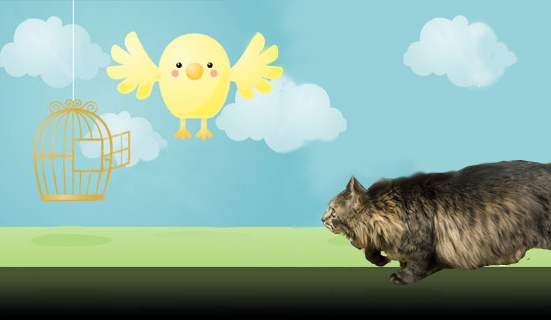

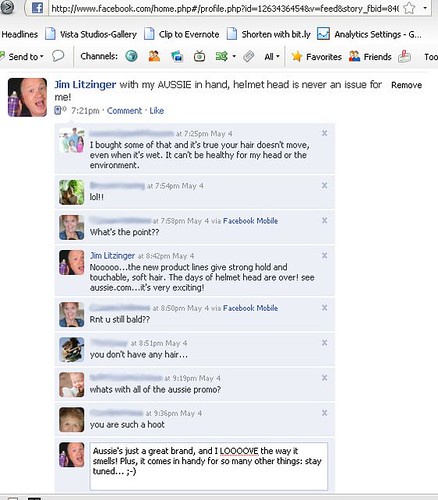














No comments:
Post a Comment